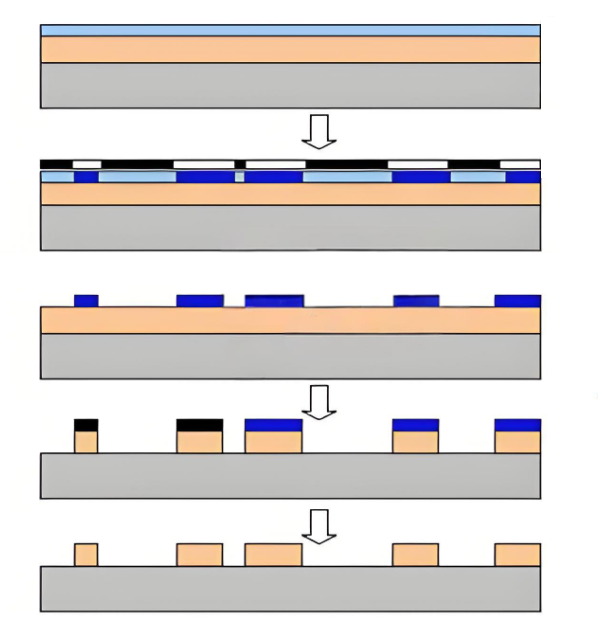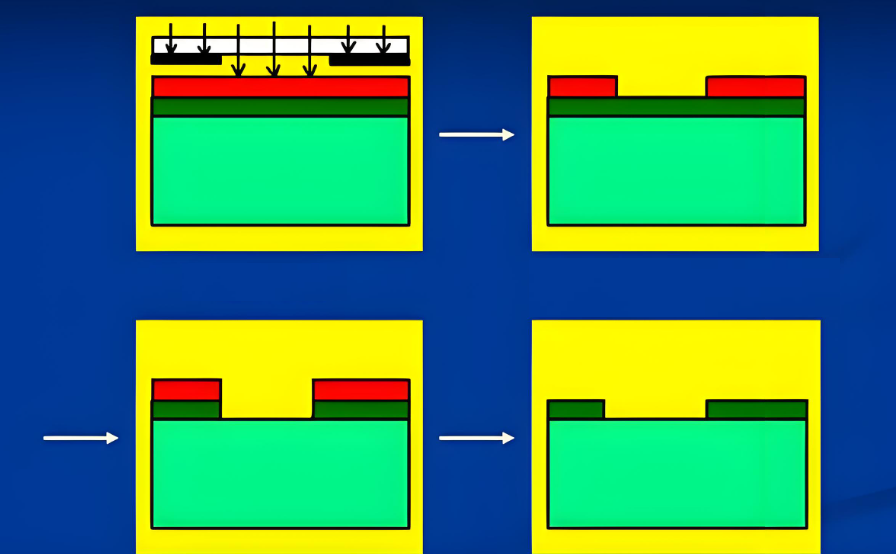Etching is one of the most critical steps in making a printed circuit board (PCB). Itâs the process that removes unwanted copper, leaving behind clean circuit traces. Whether youâre building PCBs for new projects or manufacturing at scale, understanding how PCB etching works helps you get better quality and fewer production issues.
At Best Technology, we specialize in high-precision PCB fabrication. From prototype to volume production, our team follows strict quality standards to ensure high quality PCBs. Now letâs take a closer look at the PCB etching process.
What Is PCB Etching?
PCB etching is the process of removing excess copper from a copper-clad board to form the desired circuit pattern. Itâs typically done after the copper layer has been covered with an etch-resistant mask, which protects specific areas during etching. Only the unprotected copper is dissolved away by the etchant solution.
Etching creates the circuit traces that connect electronic components. If done improperly, you could end up with broken traces, short circuits, or unreliable connections. Thatâs why itâs important to understand the entire process before getting started.

What Liquid Is Used for PCB Etching?
Several chemical solutions are commonly used for PCB etching, depending on the production scale and copper thickness. The most frequently used liquids include:
- Ferric Chloride (FeClâ): A traditional etchant used for simple or hobby PCBs. It’s affordable but stains and is hard to dispose of.
- Ammonium Persulfate (NHâ)âSâOâ: Produces cleaner results with less mess. Suitable for small-scale production.
- Cupric Chloride (CuClâ): Common in industrial PCB etching lines. It offers consistent results and can be regenerated for reuse.
- Alkaline Etchants: These are used in professional PCB shops. They provide high-speed etching and better line resolution.
Each etchant has different properties, such as etch rate, temperature sensitivity, and compatibility with resists. Industrial PCB manufacturers often choose the one that best matches their line width, copper thickness, and environmental compliance standards.
What Materials Are Needed for PCB Etching?
Before starting the etching process, youâll need the following materials:
- Copper-clad laminate: This is the raw board, coated with a thin layer of copper.
- Etching solution: Ferric chloride, cupric chloride, or another chemical agent.
- Etch-resistant layer: Typically photoresist or screen-printed resist to mask the pattern.
- Developer solution (if using photoresist): Helps reveal the resist pattern before etching.
- Protective gear: Gloves, goggles, and fume protection to handle chemicals safely.
- Etching tank or tray: For submerging and processing the boards evenly.
- Agitation system: Helps improve etching speed and consistency (manual or automatic).
- Rinse station: To stop the chemical reaction after etching and remove residues.
These materials work together to protect the circuit pattern and remove unwanted copper with high precision.

PCB Etching Process
The PCB etching process is one of the core steps that transforms a copper-clad laminate into a functional printed circuit board. It defines the copper traces that carry electrical signals between components. The goal of etching is to remove all the unwanted copper from the board, leaving only the copper paths protected by a resist layer.
1. Surface Preparation
Before etching begins, the copper surface must be completely clean and free of oxidation or oil. Any contamination can prevent the resist from adhering properly. Most manufacturers use mechanical scrubbing or chemical cleaning (like acid dipping) to ensure a uniform surface.
2. Applying the Resist Layer
Once the board is clean, a protective layer called a resist is applied to mask the areas that should not be etched. There are several ways to apply the resist:
- Dry film photoresist (DFR): Laminated using heat and pressure.
- Liquid photoresist: Sprayed onto the board.
- Screen printing: Used in simple or low-resolution PCBs.
For most precision PCBs, photoresist is preferred. It allows for fine line resolution and is compatible with automated processing.
3. Exposure and Developing
After resist application, the board is aligned with a phototool or artworkâa transparent film with the desired circuit pattern. The board is then exposed to UV light, which hardens the resist on the areas exposed to light. The rest remains soft.
The board is then placed in a developer solution, which removes the unhardened (unexposed) resist. This reveals the copper that will be etched away, while protecting the traces and pads under the hardened resist.
4. Etching
The board enters the etching chamber, where itâs sprayed or submerged with a chemical solution designed to dissolve exposed copper.
Depending on the production scale and PCB type, different etching systems are used:
- Immersion etching: The board is dipped in an etchant bath. Simple but slower.
- Spray etching: High-pressure nozzles spray etchant uniformly across the board, providing faster and more controlled etching.
- Conveyorized etching machines: Used in mass production, offering precision and speed.
The most common etching chemicals at this stage include:
- Alkaline cupric chloride (CuClâ): Efficient and widely used in high-speed lines.
- Ammoniacal etchant: Offers even faster etching, especially suitable for fine-line PCBs.
Etching is a time-sensitive process. Too short, and some copper remains. Too long, and the resist may lift, leading to undercutting or trace erosion.

5. Etch Quality Control
Quality checks are crucial right after etching:
- Line width and spacing inspection ensures the traces match the intended design.
- Cross-section testing confirms the copper thickness is within tolerance.
- Underetch detection helps avoid electrical shorts and performance issues.
High-end manufacturers like Best Technology use AOI (Automated Optical Inspection) machines to inspect every board for etch defects at this point.
6. Stripping the Resist
Once etching is complete, the remaining photoresist is no longer needed. It is removed using a chemical resist stripper, revealing clean, shiny copper traces.
This step prepares the board for further processing like solder mask application, drilling, or surface finish coating (such as ENIG or HASL).
7. Rinsing and Neutralizing
After stripping, the board goes through a thorough rinsing process using deionized water to remove any chemical residues. A neutralizing agent may also be applied to balance pH levels and prevent corrosion.
How Long Does It Take to Etch a PCB?
Etching time depends on several factors, like:
- Copper thickness: Thicker copper layers take longer to etch.
- Etchant concentration: Higher concentration speeds up the process.
- Temperature: Warmer solutions increase the etch rate.
- Agitation: Moving the solution or board improves uniformity and speed.
Typically, hobbyist etching using ferric chloride may take 10â30 minutes, while industrial alkaline etching can finish in 1â3 minutes with consistent results. Time control is criticalâover-etching can lead to side-etching and weak traces.
Calculation Method for PCB Etching Factors
Professional PCB manufacturers use a formula to calculate the etch factor, which helps balance speed and precision. The etch factor (EF) is:
EF = Depth of Etch / Undercut Distance
A high etch factor means more vertical etching (cleaner sidewalls), while a low etch factor shows more lateral etching (side erosion). This factor helps adjust etchant chemistry and exposure settings.
Key parameters include:
- Etchant type and strength
- Temperature control
- Agitation method
- Line width and spacing
- Copper thickness
By tuning these parameters, manufacturers can keep tight tolerances and maintain trace fidelity even on high-density PCBs like HDI boards.
What Should I Do if PCB Side Etching Occurs?
Side etching happens when the etchant cuts under the resist, reducing the trace width and weakening the circuit. Itâs a common issue with long etching times or incorrect resist application.
To reduce or eliminate side etching:
1. Use proper photoresist application: Ensure full coverage and adhesion to the copper.
2. Optimize exposure and development times: Underdeveloped or overexposed resist can lift during etching.
3. Shorten etching duration: Use stronger etchants or increase agitation to reduce total etch time.
4. Improve etching directionality: Spray etching is better than immersion for fine features.
5. Apply protective overcoats: For high-precision PCBs, a hard-baked resist layer or dry film helps.
In production, engineers often run test coupons alongside real boards to monitor etch quality in real time.
Choose a Professional PCB Partner â Best Technology
At Best Technology, we handle complex PCB etching challenges with advanced production lines and tight quality control. We support everything from simple single-layer PCBs to multilayer HDI PCB, flexible circuits, and even ceramic-based PCBs. Our MES system tracks every boardâs etching process for full traceability.
Whether you need prototype fabrication or mass production, we guarantee:
- High etching precision
- Clean edge definition
- Minimal side etching
- Consistent quality for fine-pitch circuits
Looking for a reliable PCB etching service? Contact Best Technology today and get your project started with confidence.
FAQs
1. What is the safest etchant to use at home?
Ammonium persulfate is cleaner and less messy than ferric chloride, though both require safety precautions.
2. Can I reuse PCB etching solution?
Yes, some etchants like cupric chloride can be regenerated, but they require careful chemical control.
3. What causes uneven etching?
Poor resist application, inconsistent agitation, or expired chemicals can lead to patchy etching.
4. How do I clean a PCB after etching?
Rinse with water, then clean with isopropyl alcohol to remove remaining residues before applying solder mask.
5. Is photoresist better than screen printing for masking?
Photoresist offers higher resolution and is preferred for fine-pitch or multilayer PCB designs.


